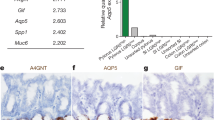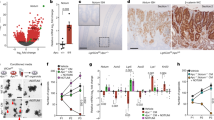Abstract
Cancer stem cells are remarkably similar to normal stem cells: both self-renew, are multipotent and express common surface markers, for example, prominin 1 (PROM1, also called CD133)1. What remains unclear is whether cancer stem cells are the direct progeny of mutated stem cells or more mature cells that reacquire stem cell properties during tumour formation. Answering this question will require knowledge of whether normal stem cells are susceptible to cancer-causing mutations; however, this has proved difficult to test because the identity of most adult tissue stem cells is not known. Here, using an inducible Cre, nuclear LacZ reporter allele knocked into the Prom1 locus (Prom1C-L ), we show that Prom1 is expressed in a variety of developing and adult tissues. Lineage-tracing studies of adult Prom1+/C-L mice containing the Rosa26-YFP reporter allele showed that Prom1+ cells are located at the base of crypts in the small intestine, co-express Lgr5 (ref. 2), generate the entire intestinal epithelium, and are therefore the small intestinal stem cell. Prom1 was reported recently to mark cancer stem cells of human intestinal tumours that arise frequently as a consequence of aberrant wingless (Wnt) signalling3,4,5. Activation of endogenous Wnt signalling in Prom1+/C-L mice containing a Cre-dependent mutant allele of β-catenin (Ctnnb1lox(ex3) ) resulted in a gross disruption of crypt architecture and a disproportionate expansion of Prom1+ cells at the crypt base. Lineage tracing demonstrated that the progeny of these cells replaced the mucosa of the entire small intestine with neoplastic tissue that was characterized by focal high-grade intraepithelial neoplasia and crypt adenoma formation. Although all neoplastic cells arose from Prom1+ cells in these mice, only 7% of tumour cells retained Prom1 expression. Our data indicate that Prom1 marks stem cells in the adult small intestine that are susceptible to transformation into tumours retaining a fraction of mutant Prom1+ tumour cells.
This is a preview of subscription content, access via your institution
Access options
Subscribe to this journal
Receive 51 print issues and online access
$199.00 per year
only $3.90 per issue
Buy this article
- Purchase on Springer Link
- Instant access to full article PDF
Prices may be subject to local taxes which are calculated during checkout




Similar content being viewed by others
References
Clarke, M. F. & Fuller, M. Stem cells and cancer: two faces of eve. Cell 124, 1111–1115 (2006)
Barker, N. et al. Identification of stem cells in small intestine and colon by marker gene Lgr5. Nature 449, 1003–1007 (2007)
Ricci-Vitiani, L. et al. Identification and expansion of human colon-cancer-initiating cells. Nature 445, 111–115 (2007)
O’Brien, C. A. et al. A human colon cancer cell capable of initiating tumour growth in immunodeficient mice. Nature 445, 106–110 (2007)
Sparks, A. B. et al. Mutational analysis of the APC/β-catenin/Tcf pathway in colorectal cancer. Cancer Res. 58, 1130–1134 (1998)
Lapidot, T. et al. A cell initiating human acute myeloid leukaemia after transplantation into SCID mice. Nature 367, 645–648 (1994)
Singh, S. K. et al. Identification of human brain tumour initiating cells. Nature 432, 396–401 (2004)
Al-Hajj, M. et al. From the cover: Prospective identification of tumorigenic breast cancer cells. Proc. Natl Acad. Sci. USA 100, 3983–3988 (2003)
Calabrese, C. et al. A perivascular niche for brain tumor stem cells. Cancer Cell 11, 69–82 (2007)
Hambardzumyan, D. et al. PI3K pathway regulates survival of cancer stem cells residing in the perivascular niche following radiation in medulloblastoma in vivo . Genes Dev. 22, 436–448 (2008)
Clarke, M. F. et al. Cancer stem cells—Perspectives on current status and future directions: AACR Workshop on Cancer Stem Cells. Cancer Res. 66, 9339–9344 (2006)
Kelly, P. N. et al. Tumor growth need not be driven by rare cancer stem cells. Science 317, 337 (2007)
Yin, A. H. et al. AC133, a novel marker for human hematopoietic stem and progenitor cells. Blood 90, 5002–5012 (1997)
Miraglia, S. et al. A novel five-transmembrane hematopoietic stem cell antigen: isolation, characterization, and molecular cloning. Blood 90, 5013–5021 (1997)
Mizrak, D., Brittan, M. & Alison, M. R. CD133: molecule of the moment. J. Pathol. 214, 3–9 (2008)
Taylor, M. D. et al. Radial glia cells are candidate stem cells of ependymoma. Cancer Cell 8, 323–335 (2005)
Hermann, P. C. et al. Distinct populations of cancer stem cells determine tumor growth and metastatic activity in human pancreatic cancer. Cell Stem Cell 1, 313–323 (2007)
Corbeil, D. et al. The human AC133 hematopoietic stem cell antigen is also expressed in epithelial cells and targeted to plasma membrane protrusions. J. Biol. Chem. 275, 5512–5520 (2000)
Kim, C. F. et al. Identification of bronchioalveolar stem cells in normal lung and lung cancer. Cell 121, 823–835 (2005)
Xu, X. et al. Beta cells can be generated from endogenous progenitors in injured adult mouse pancreas. Cell 132, 197–207 (2008)
Lois, C. & Alvarez-Buylla, A. Proliferating subventricular zone cells in the adult mammalian forebrain can differentiate into neurons and glia. Proc. Natl Acad. Sci. USA 90, 2074–2077 (1993)
Uchida, N. et al. Direct isolation of human central nervous system stem cells. Proc. Natl Acad. Sci. USA 97, 14720–14725 (2000)
Shmelkov, S. V. et al. CD133 expression is not restricted to stem cells, and both CD133 and CD133 metastatic colon cancer cells initiate tumors. J. Clin. Invest. 22, 22–30 (2008)
Bienz, M. & Clevers, H. Linking colorectal cancer to Wnt signaling. Cell 103, 311–320 (2000)
Taketo, M. M. Wnt signaling and gastrointestinal tumorigenesis in mouse models. Oncogene 25, 7522–7530 (2006)
Gaspar, C. et al. Cross-species comparison of human and mouse intestinal polyps reveals conserved mechanisms in adenomatous polyposis coli (APC)-driven tumorigenesis. Am. J. Pathol. 172, 1363–1368 (2008)
Moser, A. R., Pitot, H. C. & Dove, W. F. A dominant mutation that predisposes to multiple intestinal neoplasia in the mouse. Science 247, 322–324 (1990)
Su, L. K. et al. Multiple intestinal neoplasia caused by a mutation in the murine homolog of the APC gene. Science 256, 668–670 (1992)
Harada, N. et al. Intestinal polyposis in mice with a dominant stable mutation of the β-catenin gene. EMBO J. 18, 5931–5942 (1999)
Zhang, J. et al. Rb regulates proliferation and rod photoreceptor development in the mouse retina. Nature Genet. 36, 351–360 (2004)
Acknowledgements
R.J.G. holds the Sydney Schlobohm Leadership Chair of Research from the Brain Tumor Society and the Howard C. Schott Research Chair from the Malia’s Cord Foundation, and is supported by grants from the National Institutes of Health (R01CA129541, P01CA96832 and P30CA021765), the Collaborative Ependymoma Research Network (CERN) and by the American Lebanese Syrian Associated Charities (ALSAC). We are grateful to the staff of the ARC for technical assistance.
Author Contributions R.J.G. conceived the research, and with L.Z., planned experiments and analyses and wrote the paper; L.Z. also conducted the great majority of experiments. P.G., D.S.C., Y.T., R.J.R., I.T.B., H.P. and S.Z. conducted experiments and provided technical assistance. D.W.E. provided pathology review.
Author information
Authors and Affiliations
Corresponding author
Supplementary information
Supplementary Information
This file contains Supplementary Table 1 and Supplementary Figures 1-6 (PDF 1082 kb)
Supplementary Movie
This file contains Supplementary Movie 1 which shows the. Morphology of YFP-labelled cells in the crypt base shown in Figure 3a. (MOV 279 kb)
Rights and permissions
About this article
Cite this article
Zhu, L., Gibson, P., Currle, D. et al. Prominin 1 marks intestinal stem cells that are susceptible to neoplastic transformation. Nature 457, 603–607 (2009). https://doi.org/10.1038/nature07589
Received:
Accepted:
Published:
Issue Date:
DOI: https://doi.org/10.1038/nature07589
This article is cited by
-
Crosstalk between colorectal CSCs and immune cells in tumorigenesis, and strategies for targeting colorectal CSCs
Experimental Hematology & Oncology (2024)
-
Emerging roles of prominin-1 (CD133) in the dynamics of plasma membrane architecture and cell signaling pathways in health and disease
Cellular & Molecular Biology Letters (2024)
-
Targeting the key players of phenotypic plasticity in cancer cells by phytochemicals
Cancer and Metastasis Reviews (2024)
-
TRIM28 promotes luminal cell plasticity in a mouse model of prostate cancer
Oncogene (2023)
-
YAP is required for prostate development, regeneration, and prostate stem cell function
Cell Death Discovery (2023)
Comments
By submitting a comment you agree to abide by our Terms and Community Guidelines. If you find something abusive or that does not comply with our terms or guidelines please flag it as inappropriate.



